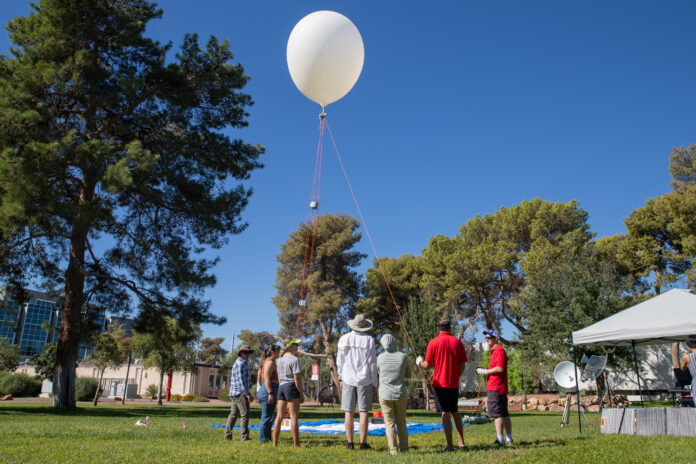
On Sept. 17, UNLV engineering students conducted a balloon test launch in preparation for the upcoming solar eclipses on Oct. 14 and April 8, 2024.
The balloon will carry a 12-pound payload and live streaming cameras 100,000 feet into the air as part of the Nationwide Eclipse Ballooning Project, where more than 50 teams nationwide will send up balloons during the eclipses. The footage of the eclipses will be streamed to NASA while other instruments collect atmospheric data.
“The purpose of the project is for community outreach,” said Matt Pusko, lead researcher on the project. “A lot of people still don’t know that the Earth orbits the sun.”
For the test launch, the balloon only went 50 feet into the air and had a balancing weight, keeping it to the ground. Students tested the electronics and practiced their roles for when they actually have to launch.
“We had a slight issue with the venting system, but otherwise, it went well,” said Rabih Chaar, a mechanical engineering junior on the project. The venting system is what was used to slowly release helium to make sure the balloon has a slow descent down to Earth.
The project involves many universities. The payloads were designed by other undergraduate students in Montana, but UNLV students have the option to improve upon their designs and use different materials. A part of the project is also being worked on by UNR students.
Pusko stated that an additional goal to the project is to detect atmospheric gravity waves. He explained that during an eclipse, the moon and the sun are in the same place relative to Earth, so the gravitational pull in their direction will be stronger. The balloons will be pulled in the direction of the sun and moon, and then pulled back down because of the Earth’s gravity.
“So what we’re looking for is for the balloons to bob up and down in the air,” said Pusko.
Kendal Harish, a senior in mechanical engineering, plays a lead role because he attended a workshop about atmospheric ballooning in Montana and was able to pass that knowledge onto his teammates.
“Everyone here is my friend so I just love working with them on this,” said Harish.
The solar eclipse on Oct. 14 is annular, meaning the moon will be farther from Earth in its orbit. When the moon crosses paths with the sun, the moon will only cover a portion of the sun and will show a “ring of fire,” as Pusko said. The eclipse on April 8, 2024 is a total solar eclipse where the moon will be closest to Earth in its orbit. This will cause the moon to completely cover the sun in the sky. It is still unsafe to directly look at the sun in either eclipse.
